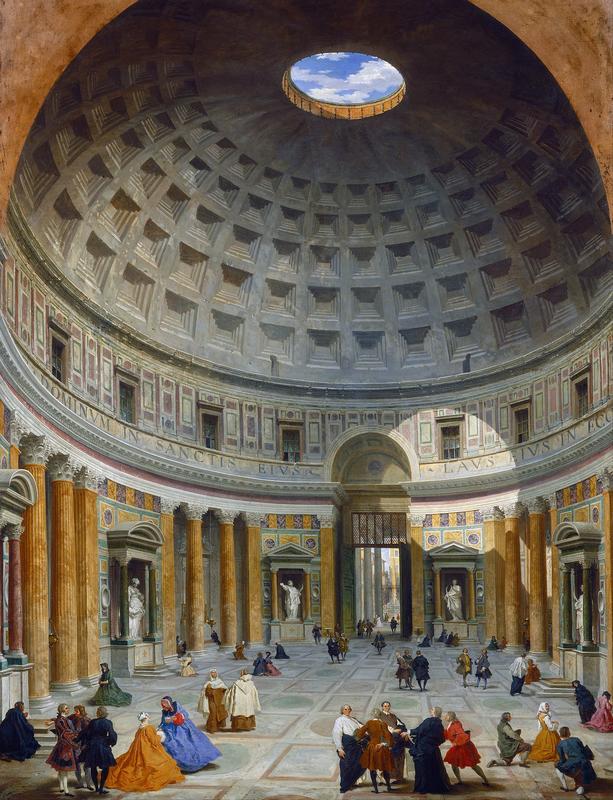More about Interior of the Pantheon, Rome

Contributor
Panini's Interior of the Pantheon, Rome is a brilliant illustration of three layers of faiths, like a big imperial lasagna, one on top of the other.
First, the Roman pagan temple practice, second, the Catholic conversion, and finally, the influence of the Catholic protection of the Roman form on the architecture of the United States, whose National Gallery of Art maintains the painting. Some of our ancestors lived in Saxony in the 1600's, and practiced various forms of Christianity, in keeping with the laws of the Empire which saw itself as preserving the legacy of Constantine. Constantine added Christian forms, like a big layer of rich, fatty ricotta, onto the national rituals of paganism and emperor-worship, and used Latin translations of the Hebrew Torah and the Greek New Testament to conquer as many nations as possible. Wherever the Empire's armies went, everyone got covered with cheese, and they had to wade through it in order to continue with their various rituals sitting quietly underneath. Generations later, some did not even know there was something under the cheese. Every ritual and custom that the marauding, troublemaking, crusading armies used as a pretense for capturing a village was already part of the heritage of those villages: ancestor-worship, bowing to statues, kissing statues, various forms of sacrifices, cutting the flesh, sexual rites, animal worship, spirit mediumship, and so on.
The genetic lines of the pagan Saxon tribal nations survived by living under a thick layer of gaudy Roman Catholicism, just like the Pantheon of Panini's painting, which is the "best preserved of all Roman buildings because it became a Christian church." 142 feet high and 142 feet in diameter, retaining the original marble, the Pantheon is the earliest example of a pagan temple converted for Christian worship in Rome.
The historian Cassius Dio writes that people may have called it the Pantheon "because it received among the images which decorated it the statues of many gods, including Mars and Venus; but my own opinion of the name is that, because of its vaulted roof, it resembles the heavens." Like people today, the Romans were into horoscopes. (Along with affairs, drinking, eating while lying down, orgies, wrestling, bloodsports, political feuds, haircuts, bathhouses, oracles, scandals, discoveries, shortcuts, war, gossip, and fanfare.)
Under the guise of Abrahamic monotheism, which, in various ways, seeks to suppress "graven images" as possible idol-worship, the Pantheon thrives, retaining its original structure and the program implied by the structure, providing an oculus to observe the heavenly bodies. Although the Hebrew injunction against graven images did not forbid artistic representation, as the temple featured flowers, cherubs and other images, the worship of the planets and the linking of one's destiny with the constellations is considered, by the Talmudic sages and Maimonides, to have become irrelevant with Moses. Marcus Agrippa, the architectural genius behind the construction of the Pantheon, built it in conjunction with a Temple of Neptune, both of which were intended for private worship. Worshipping the planets may not be as popular nowadays, but the Reagans did have a personal astrologer.
Sources
- Algranti, Gilberto. Titian to Tiepolo: Three Centuries of Italian Art. New York: Random House, 2002.
- Dio, Cassius. Roman History, University of Chicago. http://penelope.uchicago.edu/Thayer/E/Roman/Texts/Cassius_Dio/53*.html.
- Lamm, Robert Carson. The Humanities in Western Culture: A Search for Human Values. Dubuque, Iowa: Brown & Benchmark, 1996.
- Moffett, Marian. A World History of Architecture. London: Laurence King Publishing, 2003.











